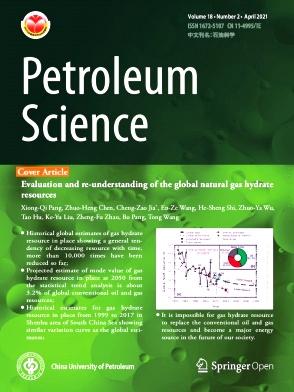致密砂岩地层超临界CO2压裂裂缝分布定量研究
IF 6
1区 工程技术
Q2 ENERGY & FUELS
引用次数: 0
摘要
超临界CO2 (SC-CO2)压裂在非常规资源开发中是一种很有前途的无水增产技术。虽然有大量研究深入探讨了SC-CO2的诱导破裂机制,但许多研究中使用的小尺寸岩石样品和合成材料限制了对非常规地层裂缝扩展的全面理解。本研究采用尺寸为300 mm的立方致密砂岩试样,在真三轴应力条件下进行SC-CO2压裂实验。对比了水致裂缝和SC-CO2致裂缝的空间形态和数量属性,探讨了地应力对裂缝扩展的影响。结果表明,SC-CO2压裂所需时间约为水压裂的10倍。在相同应力条件下,SC-CO2压裂的破裂压力(BP)比水压裂低近25%。裂缝形态定量分析表明,水压裂通常产生相对简单的裂缝模式,主裂缝分布主要受层理面控制。相比之下,SC-CO2压裂会导致更复杂的裂缝形态。随着水平主应力差的增大,SC-CO2压裂岩石BP值呈下降趋势,诱导裂缝形态趋于简化。此外,异常地应力的存在导致SC-CO2压裂的BP进一步增加,同时促进了更具导电性的裂缝网络的发育。与传统水基压裂相比,这些研究结果为SC-CO2压裂的效率和性能提供了重要的见解,为其在非常规油藏中的潜在应用提供了有价值的启示。本文章由计算机程序翻译,如有差异,请以英文原文为准。
Quantitative insight into fracture distribution during supercritical CO2 fracturing in tight sandstone formation
Supercritical CO2 (SC-CO2) fracturing stands out a promising waterless stimulation technique in the development of unconventional resources. While numerous studies have delved into the induced-fracture mechanism of SC-CO2, the small scale of rock samples and synthetic materials used in many studies have limited a comprehensive understanding of fracture propagation in unconventional formations. In this study, cubic tight sandstone samples with dimensions of 300 mm were employed to conduct SC-CO2 fracturing experiments under true-triaxial stress conditions. The spatial morphology and quantitative attributes of fracture induced by water and SC-CO2 fracturing were compared, while the impact of in-situ stress on fracture propagation was also investigated. The results indicate that the SC-CO2 fracturing takes approximately ten times longer than water fracturing. Furthermore, under identical stress condition, the breakdown pressure (BP) for SC-CO2 fracturing is nearly 25% lower than that for water fracturing. A quantitative analysis of fracture morphology reveals that water fracturing typically produces relatively simple fracture pattern, with the primary fracture distribution predominantly controlled by bedding planes. In contrast, SC-CO2 fracturing results in a more complex fracture morphology. As the differential of horizontal principal stress increases, the BP for SC-CO2 fractured rock exhibits a downward trend, and the induced fracture morphology becomes more simplified. Moreover, the presence of abnormal in-situ stress leads to a further increase in the BP for SC-CO2 fracturing, simultaneously enhancing the development of a more conductive fracture network. These findings provide critical insights into the efficiency and behavior of SC-CO2 fracturing in comparison to traditional water-based fracturing, offering valuable implication for its potential applications in unconventional reservoirs.
求助全文
通过发布文献求助,成功后即可免费获取论文全文。
去求助
来源期刊

Petroleum Science
地学-地球化学与地球物理
CiteScore
7.70
自引率
16.10%
发文量
311
审稿时长
63 days
期刊介绍:
Petroleum Science is the only English journal in China on petroleum science and technology that is intended for professionals engaged in petroleum science research and technical applications all over the world, as well as the managerial personnel of oil companies. It covers petroleum geology, petroleum geophysics, petroleum engineering, petrochemistry & chemical engineering, petroleum mechanics, and economic management. It aims to introduce the latest results in oil industry research in China, promote cooperation in petroleum science research between China and the rest of the world, and build a bridge for scientific communication between China and the world.
 求助内容:
求助内容: 应助结果提醒方式:
应助结果提醒方式:


